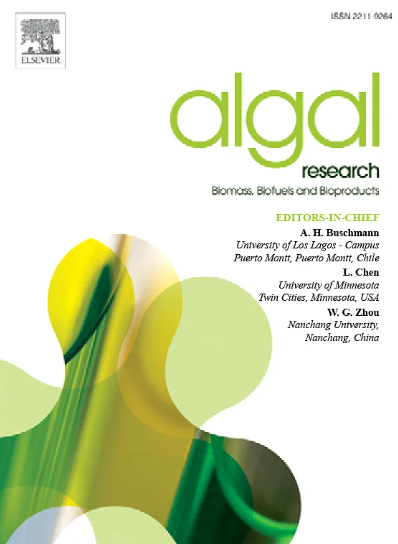Development and evaluation of an alginate-based cream formulation from Sargassum vulgare: Antimicrobial, antioxidant, and safety assessments
IF 4.6
2区 生物学
Q1 BIOTECHNOLOGY & APPLIED MICROBIOLOGY
Algal Research-Biomass Biofuels and Bioproducts
Pub Date : 2025-05-23
DOI:10.1016/j.algal.2025.104110
引用次数: 0
Abstract
This study investigates the potential of alginate extracted from Sargassum vulgare as a multifunctional ingredient in cosmetic formulations, emphasizing its antimicrobial, antioxidant, and safety properties. Alginate was extracted and characterized, then incorporated into a topical cream formulation. The antimicrobial activity was evaluated using the microdilution method against Staphylococcus aureus, Escherichia coli, Pseudomonas aeruginosa, and Candida albicans. The minimum inhibitory concentration (MIC) values were determined as 0.31 mg/mL for S. aureus and Bacillus cereus, while P. aeruginosa exhibited the highest susceptibility with a minimal bactericidal concentration (MBC) of 0.63 mg/mL. The antioxidant potential of alginate was assessed through DPPH and iron chelating assays, yielding IC₅₀ values of 13.63 mg/mL and 0.26 mg/mL, respectively. The microbiological challenge test demonstrated that the alginate-based cream formulation significantly inhibited microbial growth, notably eliminating S. aureus by day 7 and E. coli by day 28. Cytotoxicity evaluations on L929 fibroblast cells confirmed the biocompatibility of the alginate-based cream, with a higher cell viability rate (56.22 % at 1 mg/mL) compared to the standard preservative-containing formulation (35.85 %). Molecular docking studies revealed that alginate interacts with Staphylococcus aureus Sortase A (1T2W) with a binding energy of −5.9 kcal/mol and an inhibition constant of 47.7 μM, suggesting a potential mechanism for its antibacterial effects. These findings support the application of alginate from S. vulgare in cosmetic formulations, providing a natural and sustainable alternative with antimicrobial, antioxidant, and protective properties.
马尾藻藻酸盐乳膏配方的开发和评价:抗菌、抗氧化和安全性评估
本研究探讨了从普通马尾藻中提取的海藻酸盐作为化妆品配方中多功能成分的潜力,强调了其抗菌、抗氧化和安全性能。海藻酸盐被提取和表征,然后纳入局部霜制剂。采用微量稀释法对金黄色葡萄球菌、大肠杆菌、铜绿假单胞菌和白色念珠菌进行抑菌活性评价。对金黄色葡萄球菌和蜡样芽孢杆菌的最小抑菌浓度(MIC)为0.31 mg/mL,铜绿假单胞菌的最小抑菌浓度(MBC)为0.63 mg/mL,敏感性最高。通过DPPH和铁螯合试验评估海藻酸盐的抗氧化潜力,得到IC₅0值分别为13.63 mg/mL和0.26 mg/mL。微生物挑战试验表明,海藻酸盐乳膏配方显著抑制微生物生长,在第7天和第28天显著消除了金黄色葡萄球菌和大肠杆菌。对L929成纤维细胞的细胞毒性评估证实了海藻酸乳膏的生物相容性,与标准的含防腐剂配方(35.85%)相比,它的细胞存活率更高(1 mg/mL时为56.22%)。分子对接研究发现,海藻酸盐与金黄色葡萄球菌Sortase A (1T2W)相互作用,结合能为−5.9 kcal/mol,抑制常数为47.7 μM,提示其抑菌作用的潜在机制。这些发现支持了藻酸盐在化妆品配方中的应用,提供了一种具有抗菌、抗氧化和保护性能的天然和可持续的替代品。
本文章由计算机程序翻译,如有差异,请以英文原文为准。
求助全文
约1分钟内获得全文
求助全文
来源期刊

Algal Research-Biomass Biofuels and Bioproducts
BIOTECHNOLOGY & APPLIED MICROBIOLOGY-
CiteScore
9.40
自引率
7.80%
发文量
332
期刊介绍:
Algal Research is an international phycology journal covering all areas of emerging technologies in algae biology, biomass production, cultivation, harvesting, extraction, bioproducts, biorefinery, engineering, and econometrics. Algae is defined to include cyanobacteria, microalgae, and protists and symbionts of interest in biotechnology. The journal publishes original research and reviews for the following scope: algal biology, including but not exclusive to: phylogeny, biodiversity, molecular traits, metabolic regulation, and genetic engineering, algal cultivation, e.g. phototrophic systems, heterotrophic systems, and mixotrophic systems, algal harvesting and extraction systems, biotechnology to convert algal biomass and components into biofuels and bioproducts, e.g., nutraceuticals, pharmaceuticals, animal feed, plastics, etc. algal products and their economic assessment
 求助内容:
求助内容: 应助结果提醒方式:
应助结果提醒方式:


